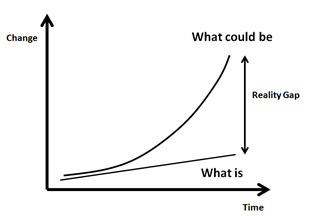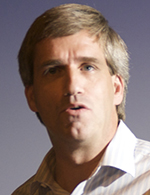By David J Hall
 The world is changing at an ever-increasing pace. But the decisions that we make and the behaviours that we display are often based on models of reality that are rooted in the past. They are therefore increasingly likely to be out of date. This lag in our thinking generates a gap between “the world that might be” and “the world that is”.
The world is changing at an ever-increasing pace. But the decisions that we make and the behaviours that we display are often based on models of reality that are rooted in the past. They are therefore increasingly likely to be out of date. This lag in our thinking generates a gap between “the world that might be” and “the world that is”.
When they operate in their own little worlds, individuals and organisations inevitably get left behind. The media is littered with examples of companies that have failed to react: Jessops, MFI, Homebase, Comet, Dwell, to name but a few.

We MUST find ways of challenging these patterns, to free up our thinking, to generate novel, creative and useful ideas that drive innovation and transform organisations, so shrinking the “reality gap”. The successful companies of the future will be those that find a way to reduce this gap.
Based on current operations alone, evidence suggests that constrained thinking is robbing us of profit – as much as 30% of turn-over! (Crosby, Quality is Free, 1979). This is the “Cost of Thinking”, the price we pay as individuals and organisations for traditional thinking, limiting our potential due to comfortable, predictable, patterned behaviour.
There are a number of blockages that operate within our brains, that fundamentally lock in the Reality Gap:
The Thinking Process: We rush into trying to solve problems (second stage thinking), rather than exploring them to develop the best understanding (first stage thinking). Usually this is not an issue as second stage thinking is a rapid, logical, process which is excellent at generating useful ideas -albeit through conventional thinking. But when conventional thinking is failing, then we need a more novel, more creative approach.
Patterning : We make sense of the world via patterns which then impact on decision making and behaviour. If those patterns are out of date, then we clearly have an issue. These patterns constrain our thinking, leading to . . .
Mind Set: The brain constrains us with imaginary rules and regulations which limit our access to a small subset of the total possible array of solutions to any given problem. This is happening continually, and yet, by definition, we do not know it.
So how can we free ourselves from the Reality Gap?
1. Embrace creativity across the organisation: We need to generate ideas that are both novel and useful. We are all excellent at generating useful ideas, but we struggle with novelty, as it challenges ingrained patterns. Whilst most are familiar with continuous improvement (doing things incrementally better), creativity (and then innovation) hold the key to discontinuous improvement (doing things differently).
2. Be more childish! Children are relatively unconstrained in thinking. We come into this world with absolutely no constraints, but build them up by the bucket-load over time, by-products of both education and experience. These constraints effectively pattern our behaviour, building a reliance on tradition and convention, trapping us in our “small worlds” and generating the Reality Gap.
3. Explore before you solve: We rush into solving problems – gathering information, processing and then generating solutions. It is automatic, quick, logical (left brain) and excellent at producing useful ideas. But if we want novelty, we need to suppress this natural urge and engage with the slower, more exploratory and reflective right brain. We need to take the time to explore problems to make sure that we have defined them correctly before reaching for a solution.
4. Employ both convergent and divergent thinking: We need to learn the value of divergent thinking, suspending judgement in order to engage the imagination. Novel and useless ideas (intermediate impossible) are a stepping stone to true creativity (novel and useful ides). The conversion of useless ideas into something useful is a convergent process, gently bringing judgement back onto the table.
5. Innovation: Be prepared to be challenged by the creative process. Generating novel and useful ideas can be a waste of time unless the ideas that emerge are actually implemented. This is the process of innovation – adding value from creativity. The blocks to creativity sit in the minds of individuals, but the blocks to innovation exist in organisational structures and cultures that reject novelty because they fear the resulting change.
 David J Hall spent 10 years as CEO of HFL Sport Science Ltd, a drug surveillance and contract research organisation based in Newmarket. Late in 2011 he left corporate comfort to pursue his passion for business transformation, founding The Ideas Centre.
David J Hall spent 10 years as CEO of HFL Sport Science Ltd, a drug surveillance and contract research organisation based in Newmarket. Late in 2011 he left corporate comfort to pursue his passion for business transformation, founding The Ideas Centre.